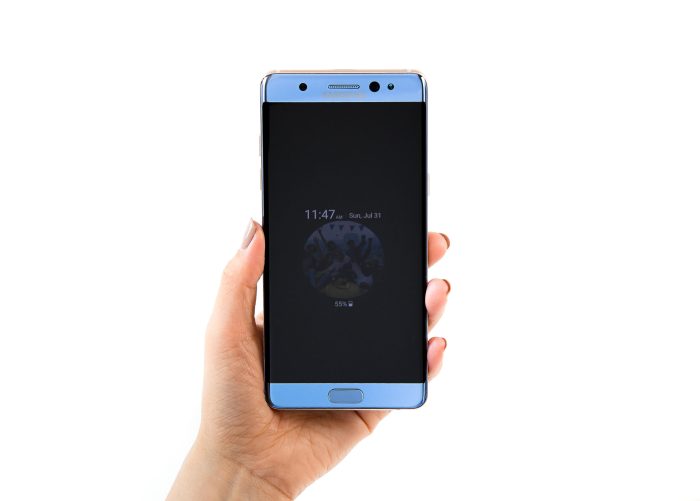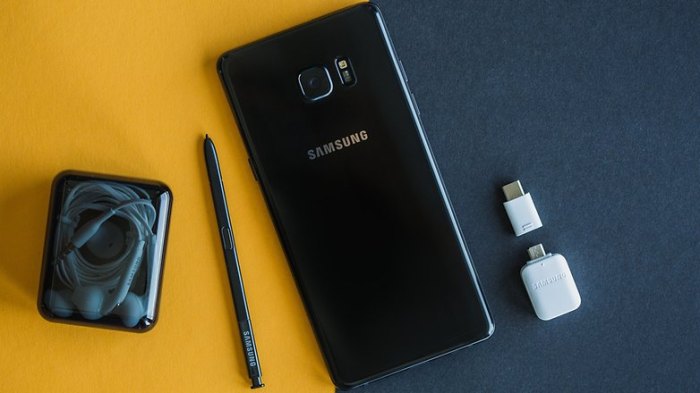Galaxy Note 7 stands as a compelling chapter in the history of smartphones, capturing attention with its ambitious features and subsequent turmoil. Released to great anticipation, it promised to redefine user experience with its sleek design and advanced capabilities. However, the device quickly became infamous due to critical battery issues that sparked widespread recalls, leaving both consumers and the market in shock.
As we delve into the intricate details of the Galaxy Note 7, we’ll explore its impressive specifications, the initial public reception, and the target audience that gravitated toward this groundbreaking device. Moreover, we’ll examine the fallout from its battery crisis, how it compared to competitors, and the lasting impact it had on future smartphone designs and user expectations.
Overview of the Galaxy Note 7

The Samsung Galaxy Note 7 was a flagship smartphone that captured significant attention upon its release in August 2016. It was designed to be a premium device, combining high-end features and specifications with Samsung’s focus on productivity and innovation. Unfortunately, its history is also marked by controversy due to battery safety issues, leading to a worldwide recall shortly after launch.The Galaxy Note 7 boasted an impressive array of features and specifications that positioned it as a leader in the smartphone market.
It featured a 5.7-inch Quad HD Super AMOLED display, a powerful Exynos 8890 or Snapdragon 820 processor (depending on the region), and a robust 4GB RAM, ensuring smooth operation for multitasking and demanding applications. The device also included a dual-pixel 12MP rear camera, capable of capturing high-quality images, and a 5MP front camera for selfies. Notably, the Note 7 was water-resistant with an IP68 rating, and it supported the S Pen, which enhanced its usability for note-taking and creative tasks.
It was equipped with a 3,500 mAh battery, which was unfortunately where the device encountered its most significant issue.
Target Market and Intended Audience
The Galaxy Note 7 was primarily targeted at professionals and tech-savvy consumers looking for a device that combined productivity with cutting-edge technology. Samsung aimed to appeal to users who valued features such as multitasking capabilities, creative tools, and a large display for media consumption. The S Pen function was a significant selling point, designed for note-taking, drawing, and enhanced navigation, making it particularly attractive to business users and creative professionals.The key demographic for the Note 7 included:
- Business professionals who required efficient communication and productivity tools.
- Content creators and designers who could utilize the S Pen for detailed work.
- Tech enthusiasts eager to own the latest high-performance smartphone.
- Users seeking a premium smartphone experience with advanced features and capabilities.
In addition to its technical specifications, the Galaxy Note 7 was marketed as a lifestyle device, integrating seamlessly into the daily lives of users who demanded versatility and reliability. Despite the unfortunate safety issues that emerged, the Galaxy Note 7 set a benchmark for future devices in the Note series and influenced the design and features of subsequent smartphones from Samsung.
Battery Issues and Recall
The Galaxy Note 7, launched with great anticipation, soon became mired in controversy due to critical battery issues that posed significant safety risks. Reports of devices catching fire or exploding prompted a massive recall that affected millions of users worldwide, significantly impacting consumer trust in the brand.The battery issues stemmed from a manufacturing defect within the lithium-ion batteries supplied by Samsung SDI, which led to overheating and combustion.
Initial investigations revealed that the batteries were prone to short-circuiting, especially under heavy usage or while charging. This alarming trend not only endangered users but also drew widespread media attention, leading to an urgent response from Samsung.
Recall Process and Customer Reactions
The recall process was unprecedented in scale, necessitating swift action to mitigate the potential dangers. Samsung initiated a two-phase recall strategy, first urging consumers to power down their devices and return them for exchanges. The steps undertaken included:
- Issuing an official announcement to inform customers about the risks associated with the Galaxy Note 7.
- Providing detailed instructions on how to return the devices safely and receive replacements or refunds.
- Involving regulatory bodies like the U.S. Consumer Product Safety Commission (CPSC) to ensure compliance and consumer safety.
- Implementing a comprehensive communication strategy to keep customers updated on the recall process and safety measures.
Customer reactions varied widely, with many expressing anger and frustration over the situation. Users took to social media to share their experiences, leading to a surge in negative sentiment towards the brand. Safety concerns were amplified as incidents of exploding devices continued to surface, resulting in increased scrutiny from regulatory agencies.
“Samsung’s Galaxy Note 7 was supposed to be a flagship device, but it turned into a safety hazard that affected the lives of many users.”
The fallout from the recall extended beyond immediate safety concerns, affecting Samsung’s reputation and stock prices. The company faced the challenge of restoring consumer trust amidst safety fears and the need for more rigorous quality control in future product launches.
Comparison with Other Smartphones

The Galaxy Note 7 was launched amidst fierce competition from other flagship smartphones, each vying for dominance in the premium market. With its advanced features and innovative design, the Note 7 aimed to carve out a unique space for itself among its contemporaries. This comparison explores how it measured up against leading competitors in terms of specifications, user experience, and pricing.
In the realm of flagship smartphones, the Asus Zenfone 7 stands out with its innovative flip camera design, enabling stunning selfies and versatile photography. Coupled with robust performance and a vibrant display, this device is perfect for tech enthusiasts who appreciate cutting-edge features.
Feature and Pricing Comparison
The comparison of the Galaxy Note 7 with its contemporaries reveals critical insights into its standing in the smartphone arena. Below is a table highlighting key specifications and price points of the Galaxy Note 7 alongside its main competitors, including the iPhone 7 Plus, Google Pixel, and LG V20.
| Smartphone | Display | Processor | RAM | Storage Options | Camera (Rear) | Battery | Price (Launch) |
|---|---|---|---|---|---|---|---|
| Samsung Galaxy Note 7 | 5.7″ Super AMOLED | Exynos 8890 / Snapdragon 820 | 4 GB | 64 GB (expandable) | 12 MP Dual Pixel | 3,500 mAh | $849 |
| iPhone 7 Plus | 5.5″ Retina HD | A10 Fusion | 3 GB | 32/128/256 GB | 12 MP Dual | 2,900 mAh | $769 |
| Google Pixel | 5.0″ AMOLED | Snapdragon 821 | 4 GB | 32/128 GB | 12.3 MP | 2,770 mAh | $649 |
| LG V20 | 5.7″ IPS LCD | Snapdragon 820 | 4 GB | 32/64 GB (expandable) | 16 MP Dual | 3,200 mAh | $799 |
The Galaxy Note 7 excelled in several areas compared to its rivals, particularly in terms of its superior display technology and battery performance. The Super AMOLED display offered vibrant colors and deep blacks, providing a visual experience that stood out against the LCD panels used by some competitors. The device’s multitasking capabilities were also enhanced by its S Pen functionality, which facilitated productivity features that were unique in this segment.The Note 7 was equipped with a 12 MP camera featuring Dual Pixel technology, which allowed for faster autofocus and improved low-light performance.
This was on par with the iPhone 7 Plus and surpassed the Google Pixel in terms of versatility, given the latter’s singular camera setup. Furthermore, the Note 7’s expandable storage option presented a significant advantage for users who required more flexibility compared to the fixed storage options of the iPhone 7 Plus and Google Pixel.In terms of pricing, while the Note 7 was one of the higher-end models, its price reflected the premium features it offered, justifying its position in the market.
The Galaxy Note 10 Lite offers a compelling blend of performance and affordability, making it a smart choice for users seeking high-end features without breaking the bank. Its S Pen functionality enhances productivity, allowing for seamless note-taking and creative expression.
The device’s combination of high-end specifications and innovative features set it apart, appealing to consumers looking for a robust and multifunctional smartphone.
“The Galaxy Note 7 was not just a smartphone; it was a productivity tool that integrated seamlessly into the user’s workflow.”
Legacy and Impact on Future Devices: Galaxy Note 7

The Galaxy Note 7’s catastrophic battery issues not only led to its downfall but also reshaped the landscape of smartphone design and safety protocols in profound ways. The incident served as a critical learning point for manufacturers and has influenced the approach to smartphone production, emphasizing safety and rigorous testing.The immediate repercussions of the Galaxy Note 7 debacle were felt across the entire smartphone industry, prompting a reevaluation of battery safety measures and quality assurance processes.
In the aftermath, companies began to adopt more stringent testing protocols, ensuring that devices underwent comprehensive evaluations before reaching consumers.
Influence on Design and Safety Protocols, Galaxy note 7
The repercussions of the Galaxy Note 7 incident catalyzed a significant shift in how smartphone manufacturers approached battery design and testing. The following points illustrate key influences:
- Improved Battery Management Systems: Manufacturers have begun incorporating sophisticated battery management systems (BMS) that monitor charge cycles, temperature, and voltage levels to prevent overheating and potential fires.
- Design Changes: Enhanced design elements, such as heat dissipation features and protective casing, have become standard to safeguard against battery failures.
- Thorough Testing Protocols: Companies now mandate rigorous pre-release testing procedures, including stress tests and real-world scenario evaluations, to identify potential issues with battery safety.
- Collaboration with Third-Party Experts: Many brands are partnering with independent safety organizations for unbiased evaluations and certifications, promoting consumer confidence.
The Galaxy Note 7’s impact stretched beyond immediate technical changes; it also ignited discussions about consumer trust within the tech community.
Long-term Brand Impact and Consumer Trust
The events surrounding the Galaxy Note 7 have had lasting implications for Samsung and the broader smartphone market. This incident significantly dented consumer trust, leading to a decline in brand loyalty that manufacturers are still working to rebuild. Analysts have noted that:
“The Note 7 crisis was a wake-up call for the entire industry, highlighting the vital importance of consumer safety over rapid advancements in technology.”
The incident prompted Samsung to initiate a comprehensive reassessment of its operations. This included:
- Brand Recovery Initiatives: Samsung launched extensive public relations campaigns to regain consumer confidence, emphasizing their commitment to safety in subsequent devices.
- Transparency in Production: The company has adopted a policy of greater transparency in its manufacturing processes, with regular updates on safety measures and product testing.
- Focus on Quality Assurance: Increased investment in quality assurance departments has become standard, ensuring that future products maintain high safety and reliability standards.
The response to the Galaxy Note 7 has also inspired innovation in subsequent smartphone models.
Innovations Following the Galaxy Note 7 Incident
In response to the challenges presented by the Galaxy Note 7, the smartphone industry has introduced several key innovations aimed at preventing similar incidents in the future. Notable advancements include:
- Battery Technology: New lithium battery technologies, such as solid-state batteries, promise higher performance and safety, reducing the risk of overheating.
- Safety Features: Integration of advanced safety features like automatic shutdown systems, which trigger in case of abnormal temperature increases, has been prioritized.
- Modular Designs: Some manufacturers are exploring modular designs that allow easy battery replacement, reducing the risks associated with aging batteries and encouraging responsible disposal practices.
The Galaxy Note 7 incident serves as a pivotal reference point in the smartphone industry’s evolution, shaping future designs and reinforcing the necessity for safety and innovation.
User Experience and Reviews

The Galaxy Note 7 garnered a mixed response from users, with many praising its innovative features while others expressed concerns about safety issues related to the battery. This section delves into the sentiments shared by consumers, highlighting both the positives and negatives experienced during the smartphone’s brief market presence. By categorizing user feedback, we can better understand the overall impact of the Note 7 on its users.
Performance
User reviews regarding the performance of the Galaxy Note 7 generally reflect high satisfaction levels. Many users reported that the smartphone delivered exceptional speed and efficiency, thanks to its powerful processor and ample RAM. This resulted in smooth multitasking and quick app launches, enhancing the overall experience.
- Fast Processing: Users praised the Snapdragon 820 processor for its impressive speed, which enabled seamless performance across various applications.
- Multitasking Capabilities: The ability to run multiple apps without lag was a common highlight among users, especially when utilizing the split-screen feature.
- Gaming Experience: Gamers noted that the graphics capabilities were outstanding, making it one of the preferred choices for mobile gaming.
Design
The design of the Galaxy Note 7 received widespread acclaim, with many users appreciating its premium aesthetics and ergonomic build. The sleek glass and metal finish, along with the vibrant display, contributed to a striking visual appeal.
- Premium Materials: Users found the combination of aluminum and glass to create a luxurious look and feel.
- Display Quality: The 5.7-inch Super AMOLED display was often described as stunning, with vivid colors and deep blacks that enhanced media consumption.
- Stylus Functionality: The S Pen was highlighted as a significant advantage, allowing for enhanced productivity and creativity in note-taking and sketching.
User Interface
Feedback on the user interface of the Galaxy Note 7 was largely positive, with users appreciating the intuitive design and customization options provided by Samsung’s TouchWiz overlay.
- Ease of Use: Many users found the interface easy to navigate, even for those who were not particularly tech-savvy.
- Customization Options: The ability to personalize home screens and app layouts was a favorite feature for those who enjoy tailoring their devices.
- Software Updates: Users were pleased with Samsung’s commitment to providing timely software updates, which kept the device running smoothly.
“The Galaxy Note 7 was a dream come true for tech enthusiasts, offering top-tier performance and stunning design.”
Despite the numerous positive reviews, it is essential to acknowledge the significant concerns raised by users regarding battery life and safety issues. Many noted that the battery, while powerful, caused anxiety due to the recall and reports of overheating. This overshadowed the otherwise impressive features of the device, creating a mixed legacy that continues to influence consumer perception of future smartphones.